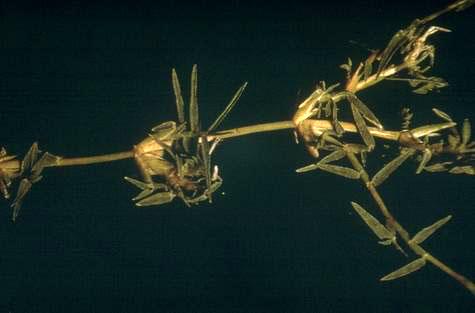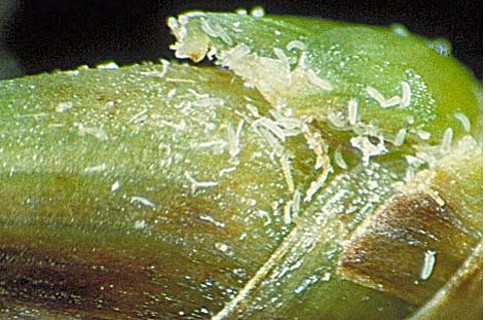Understanding Bermudagrass and Zoysiagrass Mites
- Seth Newell

- Jul 5, 2024
- 3 min read
Updated: Jul 16, 2024
Have you noticed your Bermudagrass or Zoysiagrass looking unhealthy or displaying unusual symptoms despite fertility inputs? Has your lawn appeared thin or just plain strange lately? If so, mites might be the cause of the problem. Identifying and addressing these nearly invisible pests is crucial for maintaining your lawn's health and appearance. In this guide, we'll explore the signs of mite infestation and offer practical strategies for dealing with this issue, helping you restore your grass to its vibrant, healthy state.
The Bermudagrass mite (Aceria cynodoniensis) and the Zoysiagrass mite (Aceria zoysiae) are extremely tiny, measuring approximately 1/100 inch in length, rendering them invisible to the naked eye. They possess a worm-like or sausage-like shape and are creamy white. Being eriophyid (gall-making) mites, both nymphs and adults have just two pairs of legs.
Adult mites invade sheltered parts of the grass plant, particularly beneath the leaf sheath, where they lay their eggs. The entire life cycle, from egg to adult, can be finished in five to seven days, allowing for multiple generations annually. Bermudagrass and zoysiagrass mites are most active during late spring and summer.
Damage caused by bermudagrass mites may initially be observed in early spring as bermudagrass emerges from dormancy and can worsen as the growing season progresses. Affected grass displays significantly shortened internodes, leading to a rosette or tufted growth pattern resembling a witch's broom. In cases of severe infestation, there is minimal green regrowth, and the turf forms large knots that often perish, resulting in brown patches on the lawn. Infested turf typically becomes sparse, facilitating weed growth. Mites seem to prefer well-fertilized bermudagrass over malnourished grass, and damage is more noticeable during dry spells and when the grass is experiencing stress.
Due to its slower growth rate, the zoysiagrass mite causes more harm to its host compared to the bermudagrass mite. The zoysiagrass mite shares appearance and life cycle similarities with the bermudagrass mite. Damage becomes evident when the grass emerges from dormancy, with affected leaves displaying pale white or yellow streaks and stunted growth. The upper leaf surface curls up and gets trapped within the older twisted leaves, resulting in a distinctive arch called "buggy whipping."
Search for plants that appear stunted, in rosettes, or tufted. Gently remove the leaf sheaths from the stems and inspect the uncovered area using a 10x to 20x hand lens or a dissecting microscope. Check for mites and round, see-through eggs.
The majority of bermudagrass varieties are very vulnerable to bermudagrass mite damage, except for those with African bermudagrass lineage like "Midiron," "Tifdwarf," "Tifgreen," and "Tifway," which exhibit strong resistance to the mite. Among these, "Midiron" is particularly recommended for cultivation in Oklahoma, while "Tifgreen" and "Tifway" may be suitable for certain regions.
There is a significant variation in susceptibility to zoysiagrass mites among different zoysiagrass varieties. "Meyer" is among the most susceptible, whereas "Royal" and "Emerald" exhibit high resistance, and "El Toro" shows moderate resistance.
Management practices seem to impact the severity of mite infestations significantly. Bermudagrass turf overseeded with winter grass tends to suffer more damage in spring and early summer than non-overseeded turf. Additionally, factors like thatch, irrigation, soil fertility, summer temperatures, and shade play a role in determining the level of mite damage at various points throughout the growing season.
When severe infestations are detected, mowing as low as possible (scalping the turf) and collecting and disposing of grass debris away from the site can reduce bermudagrass mite populations and subsequent damage. Afterward, minimize turf stress and promote rapid regrowth by watering the area for several days. UF/IFAS research has found that simply scalping and removing infested bermudagrass clippings can reduce bermudagrass mite damage by 50% from the time of mowing to 28 days later when the turf has regrown (Figure 6). However, this is more effective when done during late spring compared to early spring.

It's important to note that relying solely on chemical control methods may not always be effective. I recommend using a two-pronged approach to deal with the issue. This involves cutting the grass very short and removing the clippings from the property, followed by a professional treatment for bermudagrass or zoysiagrass mites. Additionally, applying nitrogen fertilizer during the early parts of the growing season can significantly reduce the damage caused by mites and assist in turfgrass repair. Treating the grass in the fall can lead to a noticeable decrease in mite-infested grass the following spring.
In conclusion, it's important to stay vigilant and regularly inspect your Bermudagrass or Zoysiagrass for signs of mite infestation. By taking proactive measures and seeking professional assistance if needed, you can help protect your lawn from damage and ensure its health and vitality for the long term. Keep an eye on any changes in the appearance of your grass, and be sure to address any issues promptly to maintain a lush and vibrant lawn.















Comments